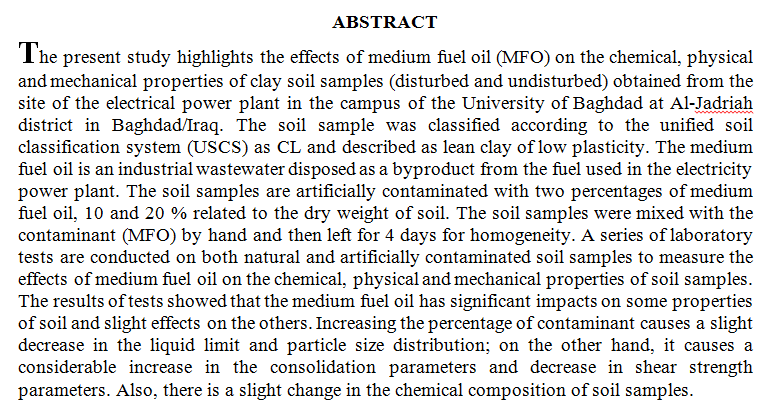
Abstract
The research Compared two methods for estimating fourparametersof the compound exponential Weibull - Poisson distribution which are the maximum likelihood method and the Downhill Simplex algorithm. Depending on two data cases, the first one assumed the original data (Non-polluting), while the second one assumeddata contamination. Simulation experimentswere conducted for different sample sizes and initial values of parameters and under different levels of contamination. Downhill Simplex algorithm was found to be the best method for in the estimation of the parameters, the probability function and the reliability function of the compound distribution in cases of natural and contaminateddata.
... Show More
 (2)
(2)
The research includes the synthesis and identification of the mixed ligands complexes of M(II) Ions in general composition [M(Lyn)2(phen)] Where L- lysine (C6H14N2O2) commonly abbreviated (LynH) as a primary ligand and 1,10-phenanthroline(C12H8N2) commonly abbreviated as "phen," as a secondary ligand . The ligands and the metal chlorides were brought in to reaction at room temperature in ethanol as solvent. The reaction required the following molar ratio [(1:1:2) (metal): phen:2 Lyn -] with M(II) ions, were M = Mn(II),Cu(II), Ni(II), Co(II), Fe(II) and Cd(II). Our research also includes studying the bio–activity of the some complexes prepared against pathogenic bacteria Escherichia coli(-),Staphylococcus(-) , Pseudomonas (-), Bacillus (-)
... Show MoreNew Schiff base ligand 2-((4-amino-5-(3, 4, 5-trimethoxybenzyl) pyrimidin- 2-ylimino) (phenyl)methyl)benzoic acid] = [HL] was synthesized using microwave irradiation trimethoprim and 2-benzoyl benzoic acid. Mixed ligand complexes of Mn((ІІ), Co(ІІ), Ni(ІІ), Cu(ІІ), Zn(ІІ) and Cd(ІІ) are reacted in ethanol with Schiff base ligand [HL] and 8-hydroxyquinoline [HQ] then reacted with metal salts in ethanol as a solvent in (1:1:1) ratio. The ligand [HL] is characterized by FTIR, UV-Vis, melting point, elemental microanalysis (C.H.N), 1H-NMR, 13C-NMR, and mass spectra. The mixed ligand complexes are characterized by infrared spectra, electronic spectra, (C.H.N), melting point, atomic absorption, molar conductance and magnetic moment me
... Show MoreBackground: This research identified Streptococci spp. depending on culture, biochemistry, the VITEK technique, ability to produce biofilms, and antibiotic resistance. Aim: The goal of this study was to perform microbiological procedures to evaluate the qualitative qualities of mozzarella cheese against infective Streptococci using microbiological care. Methods: Sixty (60) mozzarella cheese samples were brought from diverse markets in Baghdad from October 2023 to December 2023 at the Zoonoses Research Unit and Veterinary Public Health Department, Veterinary Medicine College, University of Baghdad. Culture of samples on agar (MacConkey and blood) and aerobically incubated at 37°C for 48 hours. Gram staining purified colonies to
... Show MoreA cost-effective and efficient detector was created to conduct thorough turbidimetric measurements by reaction of Co (II) ion with calcium ferro cyanide to form bright green particulate, using the method of continuous flow injection analysis, the use of NAG-5SX1-1D-SSP Analyzer in determining cobalt (II) ion in a test for the validity of the new design. The NAG-5SX1-1D-SSP Analyzer is composed of five irradiation sources of white snow leds having the diameter of 10 mm with one solar cell of 55 mm length, 13.5 mm width. Using a selector switch to select the optimum voltage to be used which was 2.7 VDC. Under conditions of optimization, cobalt (II) ion was determined at 0.005–20 mmol. L–1(n = 23) while linearity dynamic range 0.005–7 mm
... Show More (5)
(5)
synthesis and characterization of New Bidentate schiff base Ligand Type(NO)Donor Atoms Derived from isatin and 3-Amino benzoic acid and Its complexes with Co(||),Cu(||),Cd(||)and Hg(||)Ions
Objective: The aim of this study was to compare the marginal microleakage between bulk-fill, preheated bulk-fill, and bulk-fill flowable composite resins above and below cemento-enamel junction (CEJ) using micro-computed tomography. Methods: Sixty freshly extracted premolar teeth were prepared with a slot shaped cavities of a total of 120 Class II: 3mm (bucco-lingual), 2mm (mesio-distal) with mesial-gingival margin located 1mm coronal to CEJ, and distal gingival margin located 1mm apical to the CEJ. The samples were randomly divided into two main groups according to the restorative material (Tetric EvoCeram and 3M Filtek), and each group was further sub-divided into three subgroups according to the consistency (bulk fill, preheated bulk fil
... Show More (9)
(9)
 (5)
(5)
 (21)
(21)
 (22)
(22)
